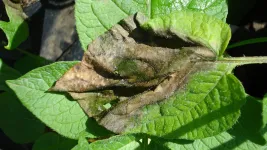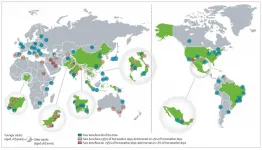Irish potato famine pathogen stoked outbreaks on six continents
2021-06-14
(Press-News.org) North Carolina State University researchers continue to track the evolution of different strains of the plant pathogen that caused the Irish potato famine in the 1840s, which set down roots in the United States before attacking Europe.
NC State plant pathologists studied the genomes of about 140 pathogen samples - historic and modern - from 37 countries on six continents to track the evolution of differing strains of Phytophthora infestans, a major cause of late-blight disease on potato and tomato plants.
The study, published in Scientific Reports, shows that the historic lineage called FAM-1 was found in nearly three-fourths of the samples (73%) and was found on all six continents.
"FAM-1 was much more widespread than previously assumed, spreading from Europe to Asia and Africa along British colony trade routes," said Jean Ristaino, William Neal Reynolds Distinguished Professor of Plant Pathology and the corresponding author of the study. "The lineage was also found over a span of more than 140 years."
FAM-1 caused outbreaks of potato late blight in the United States in 1843 and then two years later in Great Britain and Ireland. It was also found in historic samples from Colombia - suggesting a South American origin. FAM-1 caused massive and debilitating late-blight disease outbreaks in Europe, leaving starvation and migration in its wake. Ristaino theorizes that the pathogen arrived in Europe via infected potatoes on South American ships or directly from infected potatoes from the United States.
FAM-1 survived for about 100 years in the United States but was then displaced by a different strain of the pathogen called US-1, Ristaino said.
"US-1 is not a direct descendant of FAM-1, but rather a sister lineage," Ristaino said. "We found US-1 in 27% of samples in the study and they were found much later."
US-1 has since been elbowed out of the United States by even more aggressive strains of the pathogen that have originated in Mexico. Winter tomato crops - grown in Mexico and imported into the U.S. - harbor the pathogen, Ristaino said.
The study also suggests that the pathogen spread first in potatoes and then later jumped into tomatoes. Spread of the pathogen in ripe tomatoes in ships' holds would have been unlikely, Ristaino said.
The pathogen's effects aren't limited to the decimation of Ireland's potato crop some 175 years ago. Billions are spent worldwide each year in attempts to control the pathogen, Ristaino said. Potatoes in the developing world are particularly vulnerable as fungicides are less available and often unaffordable.
INFORMATION:
Amanda Saville, a research technician, works in the Ristaino lab and co-authored the paper. Funding was provided by the U.S. Department of Agriculture's Agriculture and Food Research Initiative (Grant 5197-NCSU-USDA-3179 and Grant 2011-68004-30154) and by the North Carolina Agricultural Research Service.
"Global historic pandemics caused by the FAM-1 genotype of Phytophthora infestans on six continents"
Authors: Amanda C. Saville and Jean B. Ristaino, North Carolina State University
Published: June 11, 2021 in Scientific Reports
DOI: 10.1038/s41598-021-90937-6
Abstract: The FAM-1 genotype of Phytophthora infestans caused late blight in the 1840s in the US and Europe and was responsible for the Irish famine. We examined 140 herbarium specimens collected between 1845 and 1991 from six continents and used 12-plex microsatellite genotyping (SSR) to identify FAM-1 and the mtDNA lineage (Herb-1/Ia) present in historic samples. FAM-1 was detected in approximately 73% of the historic specimens and was found on six continents. The US-1 genotype was found later than FAM-1 on all continents except Australia/Oceania and in only 27% of the samples. FAM-1 was the first genotype detected in almost all the former British colonies from which samples were available. The data from historic outbreak samples suggest the FAM-1 genotype was widespread, diverse, and spread to Asia and Africa from European sources. The famine lineage spread to six continents over 144 years, remained widespread and likely spread during global colonization from Europe. In contrast, modern lineages of P. infestans are rapidly displaced and sexual recombination occurs in some regions.
[Attachments] See images for this press release:

ELSE PRESS RELEASES FROM THIS DATE:
2021-06-14
Human papillomavirus (HPV) vaccines applied in national vaccination programs protect against most cancers associated with oncogenic, high-risk (hr) HPV types. Two recent studies demonstrate the impact of gender-neutral HPV vaccination in the overall protection against hrHPV infections already with low vaccination coverage.
More than 30 000 12-15-year-old Finnish girls and boys participated in a community-randomized trial that evaluated the impact of gender-neutral vs. girls-only HPV16/18 vaccination in the two school years of 2007-2008 and 2008-2009 in 33 communities. To evaluate the occurrence of HPV infections, pre- and post-vaccination serum samples collected in the same communities were used to measure the antibodies against ...
2021-06-14
A new high-performance plastic foam developed from whey proteins can withstand extreme heat better than many common thermoplastics made from petroleum. A research team in Sweden reports that the material, which may be used for example in catalysts for cars, fuel filters or packaging foam, actually improves its mechanical performance after days of exposure to high temperatures.
Reporting in Advanced Sustainable Systems, researchers from KTH Royal Institute of Technology in Stockholm say the research opens the door to using protein-based foam materials in potentially tough environments, such as filtration, ...
2021-06-14
WESTMINSTER, Colorado - June 06, 2021 - Many invasive plants are expanding their growing range in response to climate change, making early detection and rapid response more critical than ever. Limited resources, though, can make it impossible to track and manage every range-shifting species.
To help invasive species managers bring focus their efforts, a team from the University of Massachusetts suggests prioritizing potential invaders based on the threat they represent.
In a research project featured in the journal Invasive Plant Science and Management, the team explored data on 87 plant species that are projected ...
2021-06-14
A plant-based diet appears to afford significant protection to rats bred to become hypertensive on a high-salt diet, scientists report. When the rats become pregnant, the whole grain diet also protects the mothers and their offspring from deadly preeclampsia.
Although we have all heard to avoid the salt shaker, an estimated 30-50% of us have a significant increase in blood pressure in response to high-salt intake, percentages that are even higher and more impactful in Blacks.
The two new studies provide more evidence that the gut microbiota, which contains trillions of microorganisms that help us digest food and plays a key role ...
2021-06-14
In cultures that place a high value on conventional gender norms, particularly those that prize men as the breadwinners in a family, their unemployment plays an outsized role in whether a romantic relationship ultimately succeeds or fails.
That's according to new research from sociologists Pilar Gonalons-Pons of the University of Pennsylvania and Markus Gangl of Goethe University Frankfurt. They published their findings in the journal END ...
2021-06-14
Haifa, Israel June 11, 2021 - Using an ultrafast transmission electron microscope, researchers from the Technion - Israel Institute of Technology have, for the first time, recorded the propagation of combined sound and light waves in atomically thin materials.
The experiments were performed in the Robert and Ruth Magid Electron Beam Quantum Dynamics Laboratory headed by Professor Ido Kaminer, of the Andrew and Erna Viterbi Faculty of Electrical & Computer Engineering and the Solid State Institute.
Single-layer materials, alternatively known as 2D materials, are in themselves novel materials, solids consisting of a single layer of atoms. Graphene, the first 2D material discovered, was isolated for the first time in 2004, an achievement ...
2021-06-14
Researchers at the Keck School of Medicine (KSOM) of USC are among the contributors to a large-scale ethnically diverse genetic study that has expanded what we know about potential causes of type 2 diabetes.
The research, published in Nature Genetics, was conducted by the international MAGIC collaboration, made up of 400 global academics and led by researchers at the University of Exeter.
The study, a genome-wide meta-analysis, has identified more regions of the genome that are linked to blood glucose and insulin levels, features that contribute to the ...
2021-06-14
The build-up of calcium in a major blood vessel is linked with a 39 per cent higher risk of serious falls in older women, new Edith Cowan University (ECU) research has found.
This calcium build-up, known as abdominal aortic calcification (AAC), is a hardening of the abdomen's largest artery, which can be identified early on a commonly used bone density machine scan.
The study's findings could help health professionals to identify people at risk of serious falls early to prevent future falls and their potentially life changing consequences.
Foiling future falls
Falls are a growing public health concern, causing the deaths of an estimated 680,000 people globally each year. They are also one of ...
2021-06-14
Hokkaido University researchers have developed a simple method that converts existing generic polymers into luminescent polymers using mechanical force.
Researchers from Hokkaido University have successfully developed a new method to give luminescent properties to generic polymers, such as polystyrene and polyethylene. The technique, which was published in the journal Angewandte Chemie International Edition, makes it possible to easily prepare luminescent polymers without using complicated organic synthetic methods.
"Luminescent polymers are widely used in modern society, in applications such as organic lasers, solar cells, sensors and bioimaging, but their preparation often requires multiple chemical synthesis steps, which are both time ...
2021-06-14
The biophysical modelling study, published in The Lancet Planetary Health, challenges outdated public health guidance that discourages fan use in temperatures higher than 35 degrees Celsius / 95 degrees Fahrenheit.
Based on human studies carried out at the University of Sydney's Thermal Ergonomics Laboratory, the researchers developed a model to determine the humidity-dependent temperature thresholds at which fans could become detrimental, providing conditions that exacerbate heat stress.
"The effectiveness of a fan depends on temperature and ...
LAST 30 PRESS RELEASES:
[Press-News.org] Irish potato famine pathogen stoked outbreaks on six continents






